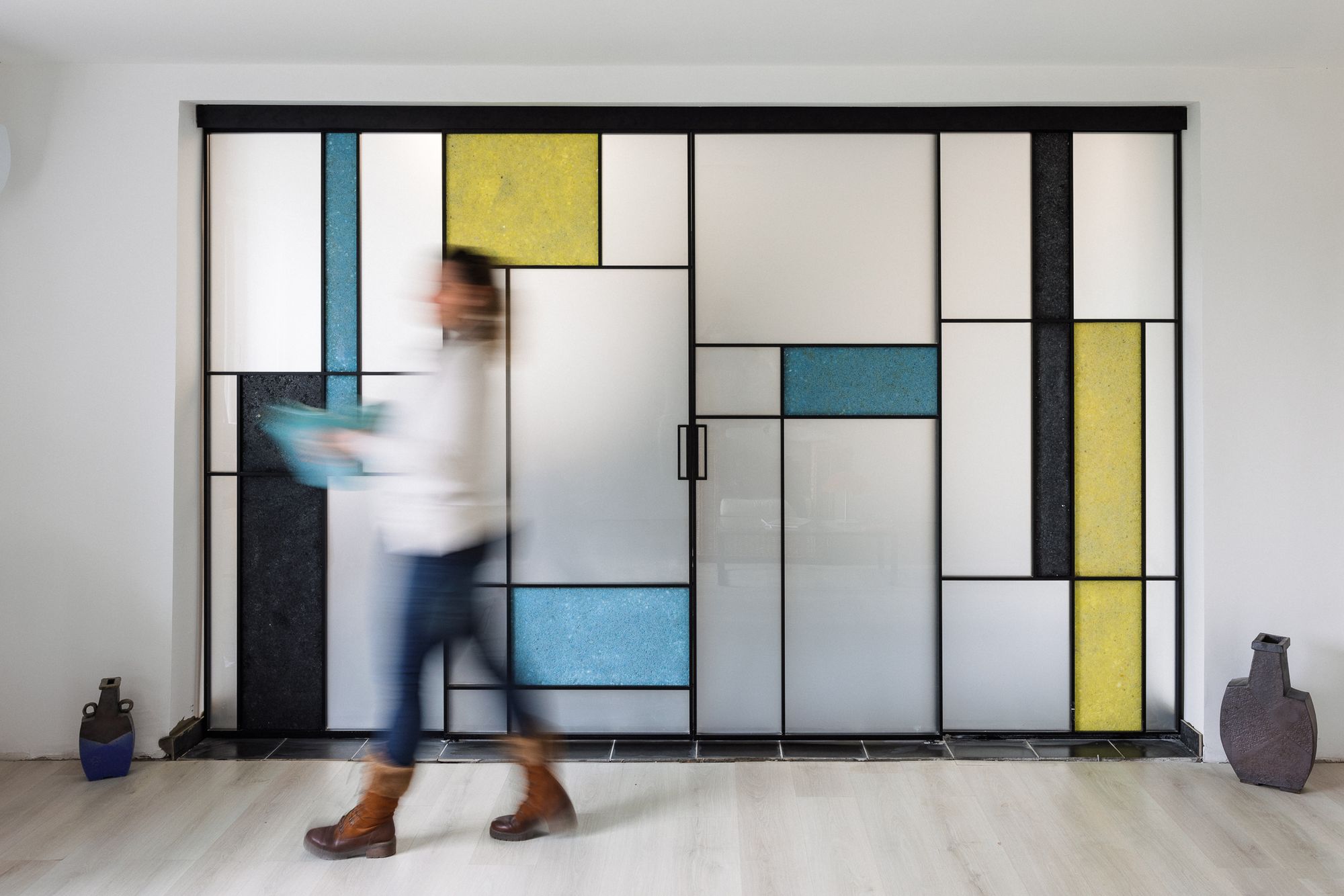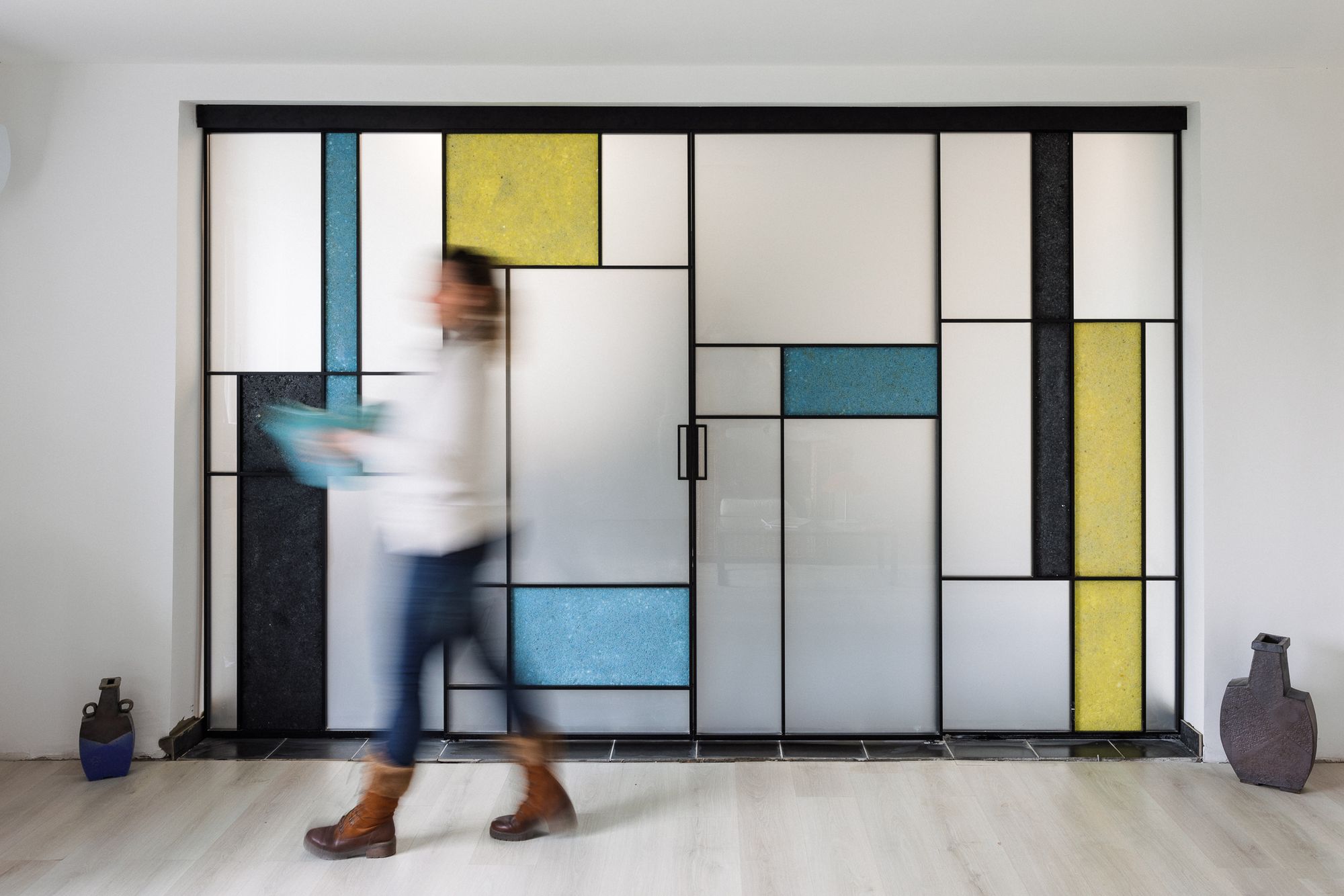Not only does she decorate homes, but she also recycles waste in her production: it took Zsuzsanna Deák two years to experiment with a completely new silicate material. The innovation, which was created by combining glass and ceramic materials, was first presented last October at the 360 Design Budapest exhibition in the form of a giant sliding door. The unique design element has now moved to its permanent home in the designer’s own showroom. We talked to Zsuzsanna Deák about the Re-built Glass project, glass, sustainable living, and recycling.
As well as her work, Zsuzsanna Deák’s life holds some unexpected twists and turns, as well. As she explained, she was raised by teacher parents, but her mother always allowed artistic genes to thrive in the family. However, it wasn’t obvious to Zsuzsanna at the beginning that glass would be her calling; as a child, she had imagined herself as an Olympic athlete. Although she was a talented kayaker, an unexpected injury in high school prevented her from continuing her sporting career. By then, she was studying in the graphic department of the art high school in Szeged. “We used to say that art had saved me,” she noted. She started working straight after high school, and it was then that her path began to drift towards the glass. She worked as a graphic designer and later as head of the decorative glass department, first at CE Glass in Szeged, then at Jüllich Glas Holding in Székesfehérvár. She was entrusted with big tasks at a very young age, and in the meantime, she started a family and continued her career as a self-employed glass designer. As an adult, she started her university studies and in 2020, she was admitted to the Ceramic Art and Design MA at the Moholy-Nagy University of Art and Design (MOME), where the story of Re-built Glass began.

The question is often raised by art historians as to whether glass art should be classified as visual or applied art. What do you think about the medium of glass?
Many people in the field of glass art are debating this question. I consider myself more of an applied artist, as I make functional objects, but nowadays it’s difficult to separate the two disciplines. Nevertheless, my work could be classified as visual art, because although my experiments with materials are based on technological knowledge, the result is unique and my works for various exhibitions are always created as the expression of an idea.
I am very fond of glass, not least because it poses thought-provoking philosophical questions. It’s fragile, just like the human soul, and the only qualitative material that can show and reveal inner forms. It brings light into our lives. What is most interesting to me about it is that it’s almost the first man-made material, a fantastic invention! It really is everywhere: in fairy tales, in science, in architecture. We can look at the universe through glass, we drink and eat from it, and we use it to store our food and our perfumes.
I’m a religious person. “You are ‘gods’,” reads the Bible. To me, this line really means that man can create, and we can live that out in the creative arts. That’s why it’s fantastic to be able to work in such a creative profession, with such a wonderful material—and yet, today we accumulate so much waste glass.



This is exactly what you are doing in your Re-built Glass project, as you are exploring the possibilities of glass waste recycling. Today, more and more designers are addressing the issue of environmental awareness and sustainability, what is your personal connection to this topic?
I think about it a lot because I don’t think we take environmental protection very seriously. For example, as part of a BA or an MA thesis, or a research project, people often look down on it because it’s such a hot topic now. My family and I changed our lifestyle two years ago and moved from the city to a farm. With the proximity of nature, we started to pay more attention to what we could recycle, and the idea of self-sustainability started to become increasingly important. We started with a few raised garden beds, then came the animals, so we now have lambs and a small pond with carp.
By the way, my decision to include recycling in my project is partly due to MOME, as the launch of Re-built Glass is also inspired by the university’s materials research course. I was also influenced by my MA thesis supervisor András Mohácsi and my consultant, glass artist János Polyák, and ceramic artists Péter Kemény and István Zakar, as an external supervisor, who all taught me a lot. I was impressed by their humanity and sensitivity behind their vast professional knowledge. As I’ve been working with glass for twenty-five years, learning more about another silicate material, ceramics, was very inspiring. Clay is the material that gave me goosebumps during the first Form Studies course of my life, as it began to form in my hands. Re-built Glass was actually born out of a combination of glass and ceramic materials. When it came to choosing a topic for my MA thesis, I chose architectural glass waste. This is interesting and challenging because some of the professionals at the university were concerned about whether something could be made from this material, as it’s considered a difficult and simple, ‘silly’ glass that cannot really be molded.

What happens with this type of waste generally? Why did you consider it important to experiment with this material?
In my thesis, I looked into the field of waste glass from both hollow and architectural glass. The recyclability of hollow glass is very well managed, although I was shocked to realize how contaminated it is arriving at the yard, despite being collected selectively. Unfortunately, however, once architectural glass is contaminated, that is painted with other materials, or it’s wire glass, it can no longer be recycled. All big companies sort it selectively, then crush it in yards, and eventually, the contaminated glass ends up buried underground. When I visited the architectural glass factories, I also discovered that there’s another material, glass sludge—produced during drilling and polishing—for which there’s also no breakthrough in recycling. So I focused my research on these two materials—glass sludge and contaminated architectural glass waste.



You have created a whole new silicate material. Please tell us about the process of material development.
During the development process, I asked the above-mentioned ceramist István Zakar for help, who works with handmade ceramic tiles. In his workshop, we first mixed glass sludge ground to zero grain size with a high-fired architectural ceramic paste, and from this, ceramic tiles were created, adapted to István’s own field. As glass is ground to one– and eight-millimeter fragments in the scrap yards, the University of Pannonia in Veszprém helped me to work with zero-grain powder—but I had to wait months for this raw material. We also started to think about how to bring the waste back to life straight away, so that we didn’t have to grind it up, which is an expensive and lengthy process. I then started experimenting in my own workshop with the additives I had asked István for. I was investigating how the glazes, masses, and plasticizers used by ceramists would affect the fully ground glass.
Glass furnaces usually work at 1300–1500 degrees to get new material, so we also tried to reduce this value during recycling. And with the furnace fusing technology, we managed to go below 900 degrees.
In fact, many people have wanted to work with ceramic and glass fusing during their MA thesis, but they have mostly aborted it because the industry claimed that these two silicate materials cannot be fused. Nevertheless, I ignored this and started experimenting with it anyway.
This is how the colored architectural glass panels made from 100 percent glass waste, four to five millimeters thick, were born and presented at the 360 Design Budapest exhibition.

Your materials research is also important because although glass waste has been recycled into glass asphalt, concrete, or synthetic resin, it has not yet been recycled into design products. And the new material you have created has taken shape as elements of a sliding door. Why did you choose this design element?
In the course of the research, elements of five different areas have emerged from the glass waste: a sustainable ceramic tile that I’d like to develop further, glass bricks, which are also part of my work and already have the prototypes and can be used for the creation of craft products and glass tiles, but I’m also experimenting with a so-called clay glass.
Once I had these new materials and possibilities, I had to think about what I wanted to represent in my work. It was at this time that we started to transform my glass workshop in Domaszék, which was a space of small windows, poorly proportioned compared to the one we have now. So, while redesigning it, the idea came up to let in more light between the two rooms: this is where the new glass door was placed. In my research, I also looked at the relationship between modern and vernacular architecture, and how old buildings are renovated and modernized. Since the former is characterized by small windows, but today we like large plate glasses, I was also interested in how to reconcile these two styles. These ideas shaped the design concept for the glass door. Although my work doesn’t reflect it now, the coloring possibilities for the architectural glass panels I created are infinite. However, as we dismantled the walls of the house, it became apparent that yellow and turquoise had dominated the space, so I chose these colors, as well.

You are not only a glass artist, but also a teacher and a glass conservator, and you are also preparing for your PhD. What are your plans and what would you like to focus on in the near future?
I’m very proud of this new silicate material, but there’s no stopping here. I want to encourage people to care about our environment, to recycle, and to want to use this new material. It shouldn’t just remain a result of a university thesis but become a real product—I’m still working on that. In fact, as a creator or applied artist, I’m starting to use the new silicate materials that have come out of this research. Whether I’m creating decorative and functional objects or various glass sculptures, I’m already considering and drawing attention to these materials.

Viva Magenta!

Mass migration could turn everything upside down










